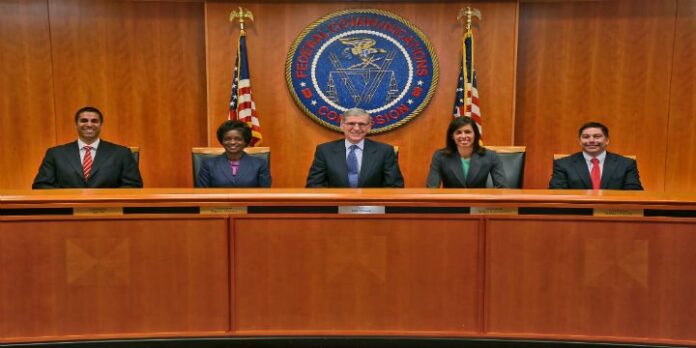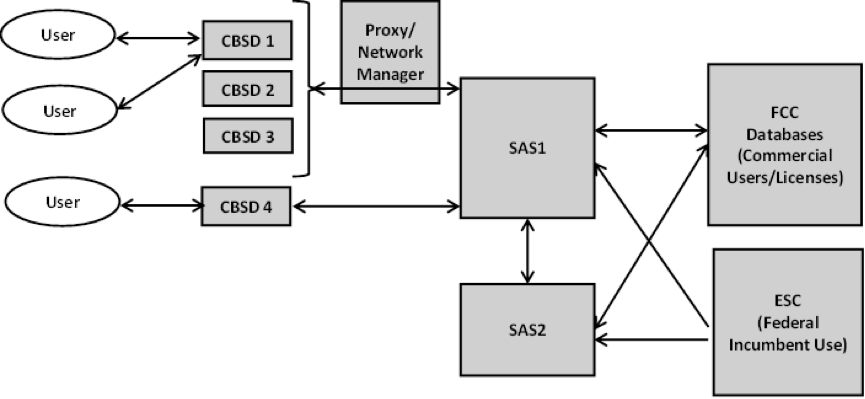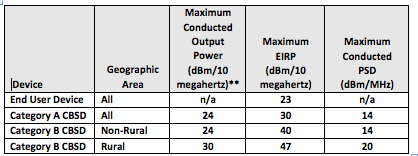3.5 GHz spectrum rules create opportunities for equipment makers and service providers
The explosive growth in mobile broadband traffic and its concomitant strain on limited spectrum resources has required the Federal Communications Commission to engage in creative frequency allocation. To that end, the Commission recently adopted rules to allow commercial shared use of 150 MHz of spectrum in the 3550-3700 MHz (“3.5 GHz”) band. The FCC, which will allow licensed and unlicensed use of the 3.5 GHz band for a wide variety of services, anticipates that its new rules will pave the way for broadband providers to implement new and innovative wireless services.
On April 21, 2015, the FCC released a Report and Order (“R&O”), containing new rules that will create a three-tiered commercial radio service called Citizens Broadband Radio Service (“CBRS”).
The 3.5 GHz market is evolving
As discussed below, the FCC’s licensed/unlicensed 3.5 GHz frequency allocation rules and polices are designed to provide a very low barrier to entry for potential CBRS providers. Unlicensed operators will have access to many frequencies and will not have to incur the expense of bidding on spectrum. Licensed operators will be subject to spectrum auctions, but with very small geographic service areas, the per-license costs should be less than licenses issued in other spectrum auctions. Licensed operators will have more interference protection than unlicensed operators, and can lease unused spectrum to other operators.
While deployment of 3.5 GHz operations is certainly in the nascent stage, a number of seminal communications companies are already developing technologies for use in the band. For example, the LTE-U Forum, whose members include Verizon, Ericsson, Alcatel-Lucent, Qualcomm, and Samsung, are working on protocol for unlicensed 3.5 GHz spectrum operations, with an expected specification publication date of March 2016. Ericsson recently teamed up with NetCom Wireless to conduct a successful 3.5 GHz trial in Australia. Qualcomm and Ericsson are expected to have various types of 3.5 GHz equipment prototypes ready by late 2015 or early 2016.
CBRS will require a new generation of radio equipment
Opening of the 3.5 GHz band for commercial use with an emphasis on unlicensed operations will undoubtedly spawn a strong demand for a new generation of RF equipment. As delineated below, CBRS will advance the use of low-power small cell technologies, including Long-Term Evolution for unlicensed spectrum (“LTE-U”) and License Assisted Access (“LAA”). These technologies and others will enable mobile broadband operators to efficiently extend their service coverage and increase network capacity, which in turn will require sophisticated, smart transmitters and end-user equipment.
Three-tiered spectrum sharing
The new rules will enable spectrum sharing and flexible use in the 3.5 GHz band by means of a three-tiered sharing system. The order of priority is: (1) incumbent licensees; (2) Priority Access (“PA”) licensees; and (3) General Authorized Access (“GAA”) operators.
The first and highest tier (“Tier 1”) consists of the incumbent federal users and fixed satellite service (“FSS”) operators. These incumbents will have complete interference protection from the two lower CBRS tiers.
The second tier is PA. A PA license (“PAL”) is an authorization to use an unpaired 10 MHz channel in the 3550-3650 MHz range in a geographic service area for a single three year period. The PA geographic service areas are census tracts, which typically align with the borders of political boundaries such as cities or counties. PA licensees can aggregate up to four PA channels in any census tract at any given time, and may obtain licenses in any available census tract. PA licensees must provide interference protection for Tier 1 incumbent licensees and accept interference from them. But, PA licensees are entitled to interference protection from GAA operators.
The third tier, GAA, permits access to 80 MHz of the 3.5 GHz band that is not assigned to a higher tier. GAA will be licensed “by rule,” meaning that entities that qualify to be FCC licensees may use FCC-authorized telecommunications equipment in the GAA band without having to obtain an individual spectrum license. GAA operators will receive no interference protection from PA or Tier 1 operators, and must accept interference from them.
SAS frequency coordination and spectrum assignment
In order to facilitate the complex CBRS spectrum sharing process, the FCC will employ a Spectrum Access System (“SAS”) – a highly automated frequency coordinator – to assign frequencies in the 3.5 GHz band. The SAS will also authorize and manage use of CBRS spectrum, protect higher tier operations from interference, and maximize frequency capacity for all CBRS operators. SAS Administrators will be permitted to charge CBRS operators fees for registration and frequency coordination services.
The SAS Administrators will authority to assist the FCC in its enforcement duties. SAS Administrators will be required to establish and follow protocols to comply with enforcement instructions from the FCC. Hence, the SAS Administrators will be the “first line of recourse” for resolving issues, especially interference disputes that could arise regarding use of the CBRS band. The FCC will retain ultimate enforcement authority, if an SAS Administrator cannot resolve issues among CBRS users, in matters of interference, unauthorized frequency and equipment use.
PA application/authorization process
The application process for PALs will commence when the FCC issues a Public Notice delineating the application window and rules. The FCC will assign seven PALs per geographic area in the U.S. When the FCC receives competing applications in a geographic area that seek a number of PALs that exceed the available supply, the FCC will assign PALs via auction. Unlike previous auctions, the FCC will not offer bidding credits to small businesses or any other specialized entity in PAL auctions.
In the event that PAL applicants for a specific geographic area do not seek PALs that exceed the available supply, the FCC will cancel the auction for that area and assign the subject spectrum for GAA use under the license-by rule method described below.
Applications for PALs are similar to those for other wide-area licenses (e.g., applicant qualifications, public interest description, corporate and citizenship information, etc.) with the additional requirement that an applicant’s proposed CBRS transmission equipment (as described below) be registered with an SAS and comply with the FCC’s equipment authorization and operational requirements.
PALs will be licensed for one three-year, non-renewable term, but the first application window will permit PAL applicants to apply for two consecutive three-year terms. PAL auctions will be held every three years. PA licensees may apply for subsequent auctions to “renew” their existing PALs and/or apply for new ones.
GAA application/authorization process
The FCC will permit qualified FCC applicants (i.e., those who have general FCC license qualifications) to utilize GAA frequencies on a shared basis without an individual license. GAA operators must employ CBRS transmission equipment that comports with applicable FCC rules and is registering with, and approved by, an SAS.
Regulatory flexibility and protocols
The FCC’s rules will permit PA and GAA operators to provide services on a common carrier and/or non-common carrier basis. CBRS operators will be permitted to provide any type of service consistent with the regulatory status in their FCC authorizations, in accordance with the rules for those services.
The FCC’s regulatory flexibility will make the 3.5 GHz band available to a wide variety of users and deployment models. For example, CBRS carriers can avail themselves of “success-based” license acquisition, deploying small cells on a GAA basis where they need additional capacity, and obtaining PALs for the surety of license protection in targeted locations where they require more interference protection. Various point-to-multipoint networks can potentially access three times more bandwidth than was available under previous 3.5 GHz rules.
It is anticipated that LTE-U and LAA protocols will be extensively utilized in the 3.5 GHz band. LTE-U and LAA are desirable technologies because they will allow carriers to expand their capacities while still ensuring that they can rely on stable licensed spectrum for high quality service. Current versions of LTE-U and LAA operate with an “anchor” licensed carrier’s channel and use carrier aggregation to integrate licensed and unlicensed spectrum, while utilizing “coexistence mechanisms” to avoid interference, ensure fair sharing with other unlicensed technologies, and enable flexible spectrum use. A standalone version of LTE-U is being developed that will utilize only unlicensed spectrum (i.e., no licensed anchor channel) and will the increase performance of unlicensed technologies to almost that of technologies that use licensed spectrum.
CBRS equipment
The FCC has very specific requirements for RF equipment that will be utilized for commercial use in the 3.5 GHz band. New RF band support will be needed on the next generation of equipment, as well as LTE-U/LAA-capable small cells to enable the deployment of the protocols in GAA unlicensed spectrum.
Due to the low transmit power requirements of unlicensed spectrum, equipment deployment (w/LTE-U/LAA capability) in the GAA band will largely be small cell technology. All such equipment, including end-user devices, must comply with the FCC’s Part 15 technical rules for power and emissions limits and Part 2 authorization and marketing requirements.
The FCC requires that transmission equipment with specific, standardized capabilities be employed by CBRS operators for use in the 3.5 GHz band. This equipment is called Citizens Broadband Service Device (“CBSD”). CBDSs are fixed stations or networks of stations. There are two types of CBDSs: Category A (a lower power CBSD) and Category B (a higher power CBSD). All CBSDs are subject to the following requirements/capabilities):
(a) two-way transmission on any frequency in the 3.5 GHz band;
(b) determinate coordinates to an accuracy of plus or minus 50 meters horizontal and 3 meters of elevation;
(c) registration with an authorization by an SAS;
(d) operate at or below maximum power level authorized by an SAS consistent with equipment authorization and within geographic areas and frequencies permitted by the SAS;
(e) receive and comply with incoming signals from an SAS regarding power limits and frequency assignments;
(f) report received signal strength in occupied and adjacent frequencies, received packet error rates and other interference metrics;
(g) if directed by an SAS, report which of the available channels it will utilize, when receiving a range of available channels;
(h) incorporate sufficient security measures to prevent corruption or unauthorized interception of data; and
(i) contain security features sufficient to protect against unauthorized modification of software and firmware.
Emissions and interference limits
The FCC has adopted the following emissions and interference limits to mitigate the possibility of interference between different users in the 3.5 GHz band:
• -13 dBm/MHz from 0 to 10 megahertz from the SAS assigned channel edge
• -25 dBm/MHz beyond 10 megahertz from the SAS assigned channel edge down to 3530 MHz and up to 3720 MHz
• -40 dBm/MHz below 3530 MHz and above 3720 MHz.
End-User Devices
CBRS end user devices are controlled by an authorized CBSD. End user devices must have the capability to receive and decode information from a CBSD. Additionally, end user devices have certain power restrictions, and must discontinue operations, change frequencies and/or operating power within 10 seconds of receiving instructions from the associated CBSD.
Conducted and power limits for CBSDs and end user equipment are illustrated in the following table:
Incumbent protection
As stated above, all CBRS operators must provide interference protection to federal incumbent and existing FSS licensees in the 3.5 GHz band. In order to protect federal incumbents, the FCC will implement Environmental Sensing Capability (“ESC”) systems, and Exclusion and Protection Zones.
Environmental sensing capability systems
An ESC is a system that detects and communicates with the presence of a signal from an incumbent federal user to an SAS to facilitate shared spectrum access and use in and adjacent to the 3.5 GHz band. ESCs will employ spectrum sensing technologies in conjunction with SASs, in order to allow CBRS users to operate near coastlines on frequencies not being used by federal radar systems. The coordination of the various CBSD entities is illustrated as follows:
Phased-in CBRS operations and exclusion zones
The FCC will implement CBRS operations in two phases. Phase I, in which large parts of the U.S. will be available for CBRS use, will commence as soon as a commercial SAS is approved by the FCC and made commercially available. Phase II, much of the rest of the U.S., including coastal cities, will be made available for CBRS operations, once an ESC is implemented and detects no federal incumbent use.
The FCC has maintained Exclusion Zones along all coastal areas in the U.S., including the Gulf Coast. During Phase I, no CBRS operations will be permitted in the 3550-3650 MHz (PA operations) in the Exclusion Zones. But, the FCC’s rules do not per se prohibit operations in the 3650-3670 MHz band, except for base and fixed stations located within 80 km of federal radiolocation sites in St. Inigoes, MD and Pensacola, FL. Operations in those areas must be approved through coordination with the National Telecommunications and Information Administration.
Once Phase I has been concluded, the Exclusion Zones will be converted to Protection Zones, in which CBRS may operate with the permission of an approved SAS and ESC.
Incumbent FSS Protection and FCC Registration Requirements
Protection of incumbent FSS operations will be accomplished by the SASs. Additionally, all incumbent FSS operators operating in the 3600-3560 and 3700-4200 MHz bands requesting protection must register with the FCC by no later than December 1 each year, providing information such as the affected earth stations’ geographic locations, antenna gain, azimuth and elevation gain patters, elevation angle, etc.
Changing regulatory landscape
As discussed herein, the FCC’s rules for 3.5 GHz deployment are varied and complex. Moreover, the 3.5 GHz regulatory environment is new territory for the FCC. It is certain that many legal and regulatory issues will arise and changes will occur as deployment proceeds. With the emphasis on unlicensed operations, equipment manufactures must be sure that they understand and comply with FCC regulations concerning specifications, technical requirements and marketing/operations. Operators will need to know the new frequency coordination procedures and ensure that proper registration and interference protection measures are taken. Potential licensees must be aware of the auctions procedures and specific licensing requirements.
Consultation with knowledgeable counsel and/or consultants would be helpful to any company looking to avail itself of the opportunities in the emerging 3.5 GHz marketplace. Successful 3.5 GHz business ventures depend not only on solid business planning, but also proactive regulatory compliance to avoid being caught in the crosshairs of the FCC’s Enforcement Bureau.



